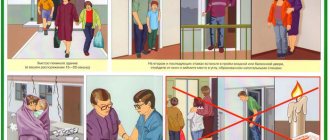When boarding public transport, we do not wait for emergency situations, such as a fire or accident. But disappointing statistics show that vehicle fires in terms of frequency of occurrence are only slightly behind fires in apartments and private houses.
When such a fire occurs, passengers are simply not prepared for it mentally and physically. But, if you know a clear procedure in case of a fire on a bus, you can not only save your life, but also help other passengers. This topic will be covered in today's article.
Basic actions in case of a fire on a bus
If a fire starts on the bus, the first thing you should not do is panic. You need to act clearly and harmoniously, and then the incident will result without casualties (Figure 1).
The main danger of such a fire is that it starts unnoticed, and people realize that the bus is on fire only when smoke is already visible or the smell of burning is clearly heard.
A passenger who notices signs of a fire must immediately notify the driver. He must open the door and allow passengers to exit the hot vehicle. However, it often happens that the fire damages the pneumatic system and the automatic doors do not open. In this case, each bus has an emergency opening button.
When all the people are removed from the bus, you need to call the Ministry of Emergency Situations and try to put out the fire with a fire extinguisher or other available means. But you should be careful and attentive: if it is clearly visible that the fire is spreading quickly, and efforts to extinguish it do not bring results, it is better not to risk your life and wait for rescuers.
Figure 1. If a bus catches fire, passengers need to get outside as quickly as possible
You should be extremely careful when extinguishing a fire also because the fire could damage the insulation on the wiring. As a result, touching any metal part or object can cause a strong electric shock.
If the doors do not open even after pressing the emergency button, you should knock out the side windows with a hard object or two feet. During the evacuation process, be sure to cover your nose and mouth with a scarf or even just a sleeve. The fact is that the interior of any vehicle contains substances that release strong toxins when burned.
Actions in case of fire on a bus, tram or trolleybus
If a fire occurs, the driver must be notified immediately. If the doors do not open after stopping (the pneumatic system is damaged), use the emergency opening button. Try to extinguish the fire using improvised means or a fire extinguisher. When extinguishing, you need to be careful not to receive a possible electric shock from metal surfaces due to burnt insulation.
If the doors cannot be opened, use the escape hatches and side windows. The glass in the windows can be broken with two feet or a hard object. If you leave the vehicle without injury, help others do the same.
You need to leave the cabin of a bus or other ground public vehicle promptly, covering your respiratory tract, since in any cabin there are materials that release toxic substances when burned. Once out, move to a safe distance. Immediately report the incident to the fire department and provide assistance to the victims.
Causes of occurrence and danger to humans
A bus can catch fire due to many factors, although most often the cause of the incident is the people themselves. A striking example is smoking while driving or transporting explosives. Both of these actions are prohibited by law, but people very often ignore the rules.
Figure 2. Most often, the driver or passengers become the culprit of the fire.
In addition, a common cause of fire is faulty wiring or equipment, careless handling of fire, or an accident. It should not be ruled out that the bus may be hit by lightning or the vehicle may be set on fire deliberately for criminal purposes (Figure 2).
Main causes of fire
If the driver properly looked after the car and regularly carried out preventive maintenance, a fire will not occur due to a technical malfunction (Figure 2).
Figure 2. A common cause of fire is the negligence of the driver himself.
But in some cases, nothing depends on the owner and a fire can be caused by:
- Short circuit, fire, or other fault in the electrical wiring.
- Failure to seal the fuel system, which leads to fuel leakage.
- High temperature of some parts due to friction.
- Smoking while driving or violating safety rules when transporting explosive substances.
In addition, the car can catch fire due to a road accident, the actions of ill-wishers or a thunderstorm.
Actions for personal protection
In the confined space of a bus interior, it is essential to protect yourself from the smoke and toxic fumes that are released when plastics and upholstery burn.
If the cabin is already filled with smoke, and you have not yet managed to get out of it, cover your mouth and nose with a scarf or any other cloth. If possible, wet the handkerchief with water.
Try to stay away from metal parts of the vehicle. If the wiring is damaged during the combustion process, you may receive an electric shock. In addition, try not to panic yourself and reassure people nearby. Your main task is to calm down and get out of the burning bus through the door or emergency exit.
Sequential actions in case of fire in a car
The safety of people in the vehicle, as well as other road users, will depend on the driver’s actions in the event of a car fire (Figure 1).
Figure 1. If your car catches fire, you need to act quickly and without panic.
Therefore, if the first signs of fire appear: the smell of smoke or gasoline, the visual appearance of fire or smoke, you must immediately stop the vehicle. Then you need to turn off the engine and remove the key from the lock.
Do not panic
Since a bus fire always happens unexpectedly for passengers, the incident is often accompanied by panic.
Remember the main rule: panic is the worst enemy of survival. In such a critical situation, it is very important to act clearly, calmly and harmoniously. Therefore, try not to shout or make sudden movements, and leave the salon calmly and in an orderly manner.
If a person next to you begins to panic, under no circumstances succumb to the general mood. Try to reassure other passengers. In some cases, a stern tone or even shouting helps. A person, being shocked, quickly switches from one emotion to another.
But don’t forget that you need to get out of the burning bus as quickly as possible. Therefore, it is still advisable to direct all your efforts to evacuation, and not to fight panic.
Actions in case of fire in a car
It is not for nothing that patrol police officers insist on annual technical inspection of all cars. The fact is that in such a confined space, even a small problem with the wiring can cause a fire, and in the worst case, lead to human casualties.
The actions of the driver and passengers in case of a fire in a car must be clear, coordinated and fast. Unfortunately, such troubles always happen unexpectedly, so you need to familiarize yourself with the algorithm of actions in such a case in advance.
What to do if the exit is blocked
Each bus has a special emergency opening button near the door. It will be needed if the fire damages the pneumatic system and the door cannot be opened automatically.
Figure 3. Each bus has an emergency exit
If this happens, you will have to get off the bus through emergency exits. Their role is played by large side windows and roof hatches. If the bus is standing upright, it is easier to get out of it through the window. To do this, you need to knock out the glass with a sharp object or two feet. You should first make sure that all other passengers are at a sufficient distance and will not be injured by glass fragments (Figure 3).
So, if the elements caught you on a bus, tram or trolleybus
First of all, immediately report the fire to the driver. If the doors do not open after stopping (the pneumatic system is damaged), use the emergency opening button. Try to extinguish the fire using improvised means or a fire extinguisher. When extinguishing, you need to be careful not to receive a possible electric shock from metal surfaces due to burnt insulation.
If the doors cannot be opened, use the escape hatches and side windows. The glass in the windows can be broken with two feet or a hard object. If you leave the vehicle without injury, help others do the same.
You need to leave the cabin of a bus or other ground public vehicle promptly, covering your respiratory tract, since in any cabin there are materials that release toxic substances when burned. Once out, move to a safe distance. Immediately report the incident to the fire department and provide assistance to the victims.
How to behave in case of fire in transport
Comments are off
In case of a fire in a car:
— stop the car and turn off the engine;
— put the car on the handbrake;
— get out of the car;
— if there are victims, help them leave the car and move to a safe distance;
- use a fire extinguisher;
— call for help by phone or through drivers of passing cars.
In the event of a fire on a bus, trolleybus or tram: - immediately inform the driver about the fire, demand that he stop and open the doors (use the emergency door opening button);
—
leave the salon as quickly as possible and without panic, helping those who are weak or in shock;
— leave the cabin quickly, covering your nose and mouth with a scarf or sleeve, since in any type of transport toxic substances are released during combustion;
— when blocking doors, use emergency hatches in the roof and side windows for evacuation. If necessary, break out the glass with both feet or a hard object;
— after getting out of the cabin, move away, as fuel tanks may explode (bus) or the high-voltage electrical network may short out (trolleybus, tram);
— report the fire to the fire brigade;
- provide assistance to the victims.
Remember! In trolleybuses and trams, metal parts may become live as a result of burnt protective insulation of wires. Do not touch metal parts or pour water on the fire.
Fire on the train
A fire on a train is scary not because of the flames, but primarily because of the toxic combustion products of synthetic finishing materials. Already in the 4th minute after the fire, their concentration exceeds the maximum permissible.
The most severe consequences occur when a fire is not detected in a timely manner (at night); in case of an outbreak of a spilled flammable liquid; when opening the door of a compartment in which a hidden fire had previously developed.
If a fire occurs:
— inform the carriage conductor about the fire;
— wake up sleeping passengers;
- stop panic;
— under no circumstances open the windows so that the influx of oxygen does not intensify the combustion;
— if you detect smoke in the carriage, cover your nose and mouth with a cloth moistened with water (towel, pillowcase, sheet, clothing);
— on a moving train, go to the next car, preferably in the direction of movement of the train, tightly closing the doors behind you;
- If possible, move on your knees, as there is less smoke below.
If exits are cut off by fire:
— go into the compartment or toilet;
— close the door tightly behind you and open the window;
— wait for help by sending distress signals.
Source: www.02.mchs.gov.ru
22.06.2014 10:17











